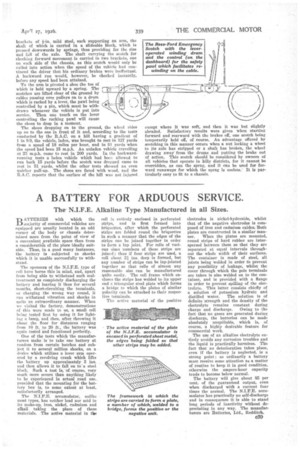A BATTERY FOR ARDUOUS SERVICE.
Page 23

If you've noticed an error in this article please click here to report it so we can fix it.
TheN.I.F.E. Alkaline Type Manufactured in all Sizes.
BATTERIES with which the majority of commercial vehicles are equipped are usually located in an odd corner of the body or chassis determined more from the point of view of a convenient available space than from a consideration of the place ideally suitable. Thus, in a good many instances, the battery is subjected to shocks which it is unable successfully to withstand.
The sponsors of the N.I.F.E. type of cell have borne this in mind, and, apart from being able to withstand such mali reatment as completely discharging the battery and leaving it thus for several months, short-circuiting the terminals, or charging the wrong way round, it can withstand vibration and shocks in quite an extraordinary manner. When we visited the factory, demonstrations of this were made to us, a small cell being tested first by using it for lighting a lamp, and then, after throwing it about the floor for distances ranging from 10 ft. to 20 ft., the battery was again tested and functioned perfectly.
One of the tests which 'the manufacturers make is to take one battery at random from certain batches and subject it to several million shocks, on a device which utilizes a lever arm operated by a revolving crank which lifts the battery up approximately 3 ins. and then allows it to fall on to'a steel block. Such a test is, of course, very much more severe than anything likely to be experienced in actual road use. provided that the mounting for the battery box is, to some extent at least, satisfactorily arranged.
The N.I.F.E. accumulator, unlike most types, has neither lead nor acid in its make-up, iron, nickel, cadmium and alkali taking the place of these materials. The active material in die cell is entirely enclosed in perforated strips, and is first formed into briquettes, after which the perforated strips are folded round the briquettes in such a manner that the edges of the strips can be joined together in order to form a lap joint. For cells of various sizes numbers of these strips are joined; thus if four strips are used, a cell about 21 ins, deep is formed, but any number of strips can be lap-jointed together so that cells of almost any reasonable size can be manufactured quite easily. The cell frame which encloses the strips has welded to its upper end a triangular steel plate which forms a bridge to which the plates of similar polarity can be attached to their respective terminals.
The. active material of the positive
electrodes is nickel-hydroxide, whilst that of the negative electrodes is composed of iron and cadmium oxides. Both plates are constructed in a similar manner. When the plates are mounted, round strips of hard rubber are interspersed between them so that they are separated at equal intervals throughout the whole width of their surfaces. The container is made of steel, all joints being welded in order to prevent any possibility of leakage, whilst the cover through which the pole terminals are taken is also welded on to the container, and is provided with a flange in order to prevent spilling of the electrolyte. This latter consists chiefly of a solution of potassium hydrate and distilled water. Th* solution is of definite -strength and the density of the electrolyte remains constant during charge and discharge. Owing to the fact that no gases are generated during discharge, the batteries can be made absolutely unspillable, which is, of course, a highly desirable feature for commercial work.
The use of an alkaline electrolyte entirely avoids any corrosion troubles and the liquid is practically harmless. The fact that no deterioration takes place, even if the battery is neglected, is a strong point; as ordinarily a battery must receive some attention as a matter of routine to keepit in good condition, otherwise the ampere-hour capacity tends to become below normal.
The battery will give about 85 per cent. of the guaranteed output, even when discharged with a current four times the normal. The N.I.F.E. accumulator has practically no self-discharge and in consequence it is able to stand long periods of inactivity without depreciating in any way. The manufacturers are Batteries, Ltd., Redditeh.
































